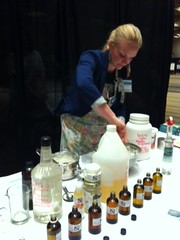In July, 2011 the City of Toronto began consideration of a consultant's report that identified several "opportunities" for budget reductions. On the list was the elimination of the Toronto Environment Office, the City equivalent of a Ministry of the Environment. This put at risk environmental programming such as Community Environment Days, waste diversion programs, urban agricultural programs, tree planting and the Live Green program among others.Women's Healthy Environments Network (WHEN) added its voice to the chorus defending these programs. Here is what we said:
WHEN's Deputation to the City of Toronto on July 18, 2011
Since its inception in 1994, Women's Healthy Environments Network (WHEN) has been educating the general public, media and policy makers to the fact that environmental health is a key determinant of public health.
Our vision is a future where every person lives free of exposure to environmental health risks.
WHEN actively promotes the primary prevention of environmentally linked health conditions such as cancer, asthma, immune system related conditions and others by advocating the reduction of toxic emissions into our air and water; more efficient, renewable energy sources; affordable public transportation; biological agriculture and lawn care; safe disposal of hazardous materials and more. We strive to raise awareness of the environmental health risks that must be addressed for sustainable and healthy societies and communities.
WHEN was moved to action by the fact that each year millions of Canadians and their families are affected by cancer (carcinogens), reproduction issues (endocrine disruptors), and childhood neurological disorders (lead, mercury). Using the precautionary principle, we illustrate to people that the best way to prevent health risks is to avoid using these products, reduce our air emissions, and provide safe disposal of hazardous goods to ensure that they do not end up in the water stream, affecting us all.
While WHEN focuses on the primary prevention of women's reproductive health problems, it also addresses other environmentally linked health issues. Recognizing that growing numbers of people are calling for clean and safe air, food, water and soil, WHEN routinely organizes and participates on many different levels in a variety of activities: informational workshops, do-it-yourself sessions, film screenings, public discussions, conferences and displays at eco-friendly events in various venues such as communities, schools, universities, and workplaces.
WHEN builds networks with others at local, national and international levels to engage and educate about the links between the environment and our health.
Why the City’s Environmental Programs Matter:
As a small organization with a broad mandate and a limited budget, we can sympathize with the city’s struggles to be financially stable. But we fundamentally disagree with the removal of the environmental programming from the City’s mandate as a means of reaching its financial goals. Removing these services will increase the financial risk of future city administrations by removing opportunities and incentives for waste reduction and safe disposal. We respectfully urge the members of this committee not to react to the current financial situation, which has built up over years, with more short-sightedness.
Environmental programming is inclusive and contagious:
Dozens of organizations are working every day at the community level with small groups of individuals to affect change. For example, as part of WHEN’s work, we deliver workshops to newcomer women and families focused on health issues and how they are influenced by our environment. These workshops help participants identify and problem-solve the issue of household and public exposure to cancer-causing agents in both a local and diversified environment.
Since May 2010, WHEN has hosted these seminars in Toronto and Mississauga, reaching over 100 women and families from diverse regions such as South Asia, the Middle East, Africa, and Latin America. Given that life in Canada is primarily spent indoors, the sessions emphasize “healthy homes”, featuring demonstrations, interactive discussions, and questions and answers about environmental exposures affecting health. We have focused on topics such as home gardening and pest control, indoor air quality, cleaning and personal care products, and waste reduction and recycling.
As you all know, Toronto is a city of immigrants. At WHEN we have found tremendous interest among newcomers to the environmental information we are providing. People coming to Toronto from around the world are attracted to the benefits this City and country can offer them and their family, and the quality of life they seek includes environmental sustainability and good health. Newcomers are focused on basic necessities –housing, employment when they arrive. As they get to know the City they are becoming part of, they begin to understand the values and culture of the place. City government can be a major positive driver in that regard.
Environmental programming works for the long term:
As a city, a country, a planet, we have substantial work to do to reduce our ecological footprint, lower our energy consumption, reduce our waste generation and address climate change. These are overwhelming objectives, but ones that we don’t have the luxury of delaying another generation. In the last decade, Toronto has become known around the world for stepping up to these challenges. Our tree coverage targets and waste diverse targets are impressive, and more importantly they are beginning to demonstrate a difference! Removing these targets now, and the modest budget efforts to encourage these actions, would seriously harm the quality of life Torontians are striving for.
It is our experience that changes in behaviour require constant reinforcement, and in some cases a generation of effort, before they take hold. Think of recycling for basic materials – it is routine now to see low rise housing to put as much out in recycling bins as in garbage for weekly pick up, or to see people put their waste bottles and cups in the recycling slots instead of the garbage slots along downtown Toronto streets. But apartments and higher density housing developments do not have the same options for waste diversion (no composting and less successful recycling rates). Toronto’s work is far from done in this regard, and for the City to move away from environmental waste diversion programming would be extremely premature.
WHEN has also seen firsthand the importance of the Community Environment Days program. This year, we have participated at many of these events across Toronto’s diverse neighbourhoods, and spoken with many of the people who attend. These are not environmental advocates. These are everyday residents of Toronto who recognize that we all need to do more. They are eager to talk about their contributions to the kind of environment they want to live in, and interested in information about what else they can do. These are people who have been saving paint cans, old batteries, computer screens and other materials for over a year, not knowing exactly why they are bad to dump into a landfill, but very conscious they are looking for alternatives. People of all ages, all walks of life, come to those events. These events don’t just attract crowds at downtown core locations, but across the City. If anything, these events should be more widely promoted, not cancelled! I would like to highlight a page from the Core Services Review Public Consultation, Appendix B to the City Manager’s Report on the Core-Service Review, which indicates that over 80% of respondents felt that environmental issues were an important public policy issue – which was rated higher than jobs and a healthy economy.
Participating in the community environment days has been a fantastic experience for our organization and other community organizations who attend the events. We attend them to speak with people about making safer consumer choices and encouraging safe disposal. We have been able to reach Torontonians who we would normally not have an opportunity to reach and have engaging discussions with people to help them advocate for themselves and their families and learn from them as well, so we can build as an organization. We are a small organization and do all of our own fundraising, like many other community organizations. Having this opportunity to work with the community environment days team has been a wonderful opportunity and provided us with infrastructure to grow our organization and reach a broader population. The events have a much larger impact that the core programming, by coalescing community groups, community leaders, and residents.
Our Plea:
We respectfully ask the members of this committee that in assessing the recommended cuts, you think about the diversity of this City, and the long term challenges we are facing as a City and a planet. The City of Toronto’s environmental programming is something to be very proud of. It supports the will of residents throughout the city, the health of our water and air, and community organizations by providing leadership and catalysis. It is an area of programming that can touch all Toronto residents. The environment is not a special interest category in the City’s budget. It is our future.








